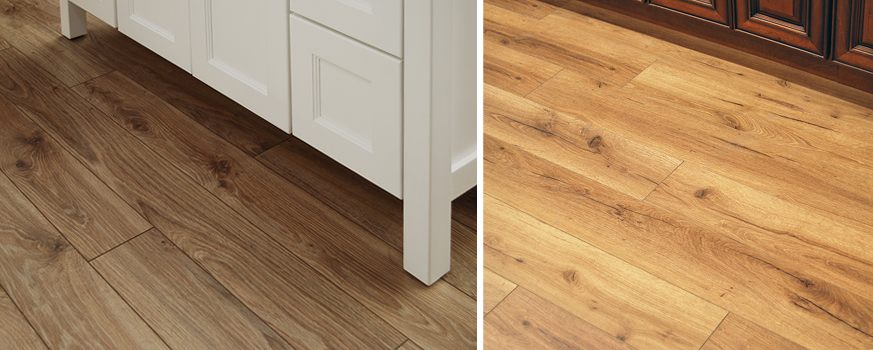
Most vinyl flooring options are made of polymer materials, which make them moisture resistant. Vinyl may also look like natural wood or stone depending on the embossing technique used by the manufacturer, but homeowners need to look for vinyl flooring with a thicker core to achieve the style they want. When it comes to style and appearance, laminate flooring is superior to vinyl because it comes in realistic embossing that makes it look similar to real wood. Laminate is usually thicker than vinyl, which makes it more comfortable to walk on. The design layer is a printout of a natural material (like stone or wood) covered by a transparent and protective wear layer. On the other hand, laminate flooring has wood byproducts and resin for its core layer. They also emboss the material with a specific design and finish it off with a protective layer like polyurethane. Most manufacturers utilize fiberglass, plasticizer, and PVC vinyl to manufacture the base layer of the vinyl sheet. Different types of vinyl flooring are usually created with synthetic materials. The key difference between laminate and vinyl is the material used in making them. Here are some of the important features of vinyl and laminate that set them apart: Appearance and Material However, there are important differences between laminate and vinyl that make one better than the other in some situations. Laminate Flooring: Which is Better?īoth laminate and vinyl are budget-friendly flooring options with a couple of similarities, which is why many people confuse them with each other. For living rooms, kit There’s actually no easy answer to which is the superior choice because there are factors to consider, but it’s all up to you at the end of the day. For bathrooms and laundry rooms, vinyl is the better option because of its heat and moisture resistance. So which between laminate and vinyl is the better flooring material for a house? Laminate and vinyl flooring are both durable but affordable flooring types. While there are many materials you can choose from, laminate and vinyl remain to be the most popular options for many homeowners. The right flooring supplies the needed pop to your otherwise dull space. Some vinyl floors even emit chemicals into the air after installation in the case of a fire, this danger increases.Choosing a flooring option is just one of the many decisions you need to make when building or remodeling a home. However, the synthetic materials-plastic, fiberglass and PVC, for example-that comprise vinyl are not environmentally friendly. While it does need to be swept and cleaned often, it doesn’t have to be resealed like linoleum. It’s also very durable, so it’s good for high-traffic rooms. Vinyl flooring has superior waterproof properties, making it the better choice for high-moisture areas in your home. And because linoleum is made from natural materials, it is a more environmentally friendly floor option. In the event of a house fire, a linoleum floor will not emit toxins like a vinyl floor would.

Linoleum can stand up to heat much better than vinyl, not just in terms of wear and tear, but also for your health. For this reason, it’s not an ideal flooring option for the kitchen, bathroom, laundry room or any other area that is susceptible to moisture or humidity. Sealed linoleum is water-resistant, but you must maintain that seal in order to preserve your flooring from water damage. Vinyl Flooring: Major Differences, Pros, Cons And Costs While we work hard to provide accurate and up to date information that we think you will find relevant, Forbes Home does not and cannot guarantee that any information provided is complete and makes no representations or warranties in connection thereto, nor to the accuracy or applicability thereof. The compensation we receive from advertisers does not influence the recommendations or advice our editorial team provides in our articles or otherwise impact any of the editorial content on Forbes Home. Second, we also include links to advertisers’ offers in some of our articles these “affiliate links” may generate income for our site when you click on them. This site does not include all companies or products available within the market. The compensation we receive for those placements affects how and where advertisers’ offers appear on the site. First, we provide paid placements to advertisers to present their offers. This compensation comes from two main sources.
#Laminate vs vinyl flooring for free#
To help support our reporting work, and to continue our ability to provide this content for free to our readers, we receive compensation from the companies that advertise on the Forbes Home site.
/vinyl-vs-laminate-flooring-1822800_0372-5de7d94ebd85420f98f8c45e5bf8f670.jpg)
The Forbes Home editorial team is independent and objective.


 0 kommentar(er)
0 kommentar(er)
